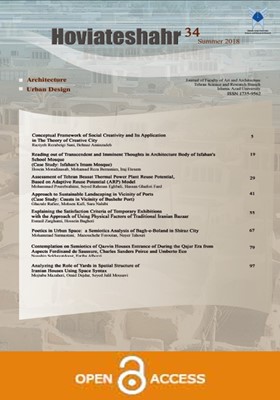Examining the Relationship between Psychological Adaptation to Achieve Thermal Comfort with a Sense of Place in Urban Areas (The Case Study of Imam Hussein and Imam Khomeini Square in Tehran)
Subject Areas : urbanismelham zabetian 1 * , reza kheir e din 2
1 - Ph.D. in Urban Studies, Researcher at BHRC (Building Housing Research Centre in Minis try of Road & Urban Development), Tehran, Iran.
2 - Associate Professor, Department of Urban and Regional Planning, Academic Member of Faculty of Architecture and Urban Planning, Iran University of Science and Technology, Tehran, Iran.
Keywords: ", Sense of Place", , ", Urban Space", , ", Psychological Adaptation", , ", Thermal Comfort Perception", , ", Attachment Sense", ,
Abstract :
Most studies on thermal comfort in urban spaces have been focused on physical factors, while thermal adaptation is one of the most important factors in the perception of comfort. Up to now, in most studies on thermal comfort and adaptability of individuals with micro climatic conditions in urban public spaces or residential areas in Iran, just studies of physical and physiological factors and physical suggestions such as changes in the form of building, density, vegetation species, landscaping and land use planning have been conducted. Of course, there are some studies on thermal comfort perceived (not felt)and combination of physical and objective studies with mental, social and environmental psychological studies with a collaborative approach to the visitors to the space in some countries of the world; but the psychological variables studied (especially in the field of thermal adaptation) generally include the effects of the factors such as naturalness, expectation, experiences and time of exposure and perceived control on space. Although the mentioned variables have been not studied in the form of urban public spaces according to the climatic and cultural-demographic conditions of different regions in Iran in a comprehensive study, the main goal of the present study is the effect of the sense of place component on perceived thermal comfort and thermal adaptation of individuals which have been not considered in previous studies. By studying the relationship between the two concepts of thermal adaptation and sense of place, in order to promote the thermal comfort of the people in an urban space and generalize it to a variety of comfort conditions in a space, it is possible to decide better in the planning process to achieve the goals of an urban space. Since we will not have a space with a physical comfort, but without an adequate sense of place which encounters a lack of attraction of people compared to spaces that although the lack of comfort, but have enough sense of place. Therefore, expanding the concept of perception and its difference with feeling is one of the key goals of the present research. The hypothesis of the present study is that: "There is a direct relationship between thermal adaptation in order to reach thermal comfort and different levels of a sense of place in urban spaces. "The experimental model of this study has been extracted after conceptualization and explained by Delphi method and then, a questionnaire corresponding to each component of the model was developed by surveying in two urban spaces in Tehran city and filled out by 200 citizens presenting in the two places in cold season and then analyzed using statistical tests, including T-test, correlation and Beta. The results indicate that, it was also found that there is a direct correlation between the two variables of sense of place and individuals’ thermal adaptation in order to achieve the thermal comfort (the proof of the main research hypothesis). Finally, some strategies have been provided to improve the thermal adaptation and sense of place and to increase the mentioned correlation.
_||_

